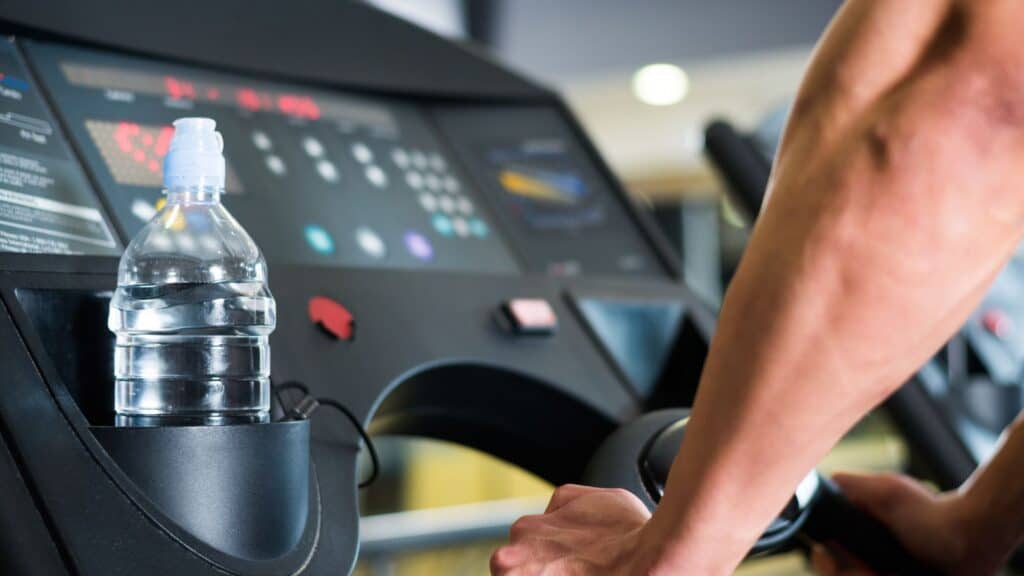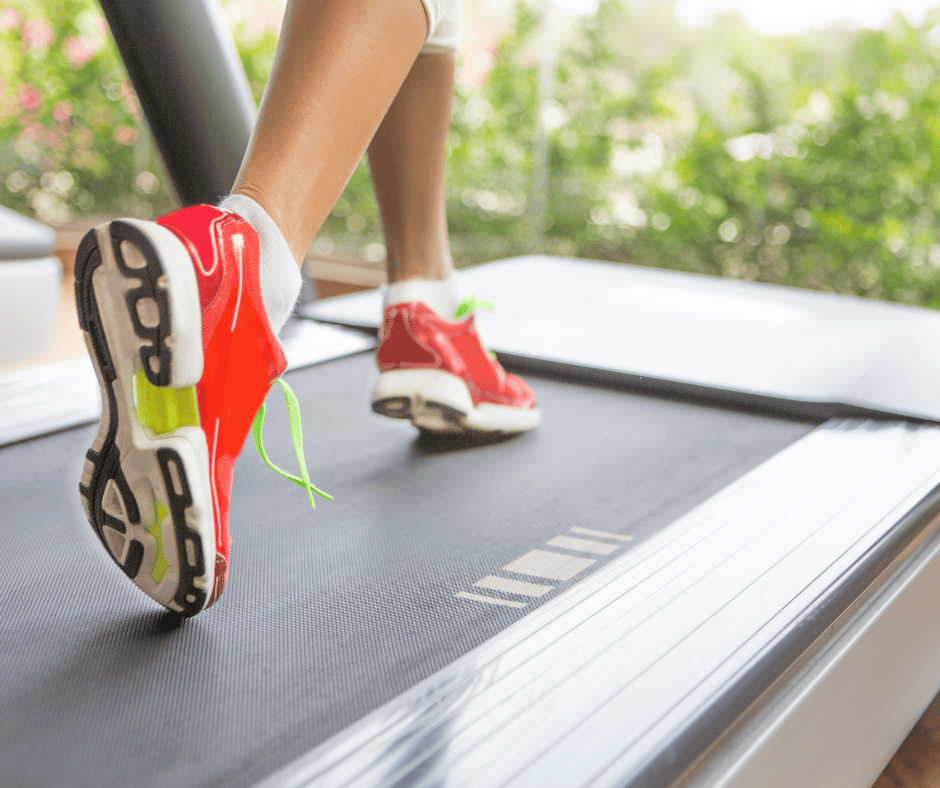It is possible to train for a marathon on a treadmill. It’s an effective way to train, especially when you can’t run outdoors for reasons such as cold weather, rain, heat, etc.
One benefit of treadmill training is that you get to train consistently. Plus, it helps you build up endurance, giving you an advantage on race day.
However, be mindful of the drawbacks of running indoors, and be sure to challenge yourself with long outdoor runs as much as possible. Then use indoor days to do targeted speed, incline, and tempo runs as needed
In this article, we will provide you with valuable tips and insights to support all you dedicated treadmill warriors who are training for the Boston Marathon.
So, let’s dive in….

Five Tips For Boston Marathon Training On A Treadmill
If you’re considering using a treadmill as your marathon training companion, it’s important to keep in mind a few key factors.
By paying attention to these points, you’ll be able to make the most of this valuable training tool and maximize your benefits:
- Optimal Treadmill Settings to Replicate Outdoor Running
- Treadmill Speed Workouts For Marathon Training
- Long Marathon Training Runs On The Treadmill
- Stay Hydrated While Training on The Treadmill
- How To Recover After Training On The Treadmill
- Optimal Treadmill Settings to Replicate Outdoor Running
Experienced runners will often tell you that running on a treadmill and running outside are like two different worlds! And this is true.
When you step on a treadmill, you miss out on the wind resistance that you encounter when running outdoors. But don’t worry, there’s a way to mimic the outdoor running experience more effectively.
To mimic the energetic cost of outdoor running, researchers suggest setting the treadmill at a gentle incline of 1%. This little adjustment compensates for the lack of wind resistance and brings you closer to the real deal.
However, here’s a little secret: the 1% incline doesn’t quite capture the full picture.
Running on a moving belt introduces some unique biomechanical aspects that we need to consider too…
What You Need To Know About Running on an Inclined Treadmill
There’s more to gain from adding a slight incline to your treadmill running than just compensating for the lack of wind resistance.
When you transition from running outdoors to a treadmill, there are a few key differences to consider. One significant contrast is the role of your glutes and hamstrings in propelling you forward during each stride.
When running outdoors, you rely on your glutes and hamstrings to generate the necessary effort for forward propulsion.
However, on a treadmill, the constantly moving belt can assist in this propulsive work, reducing the demand on those muscle groups.
To bridge this gap and better simulate outdoor running, I recommend increasing the incline to about 3% for your “flat” treadmill runs.
However, it’s important to note that this recommendation may not be suitable for everyone. If you are new to treadmill running or a beginner runner, it’s advisable to start at a 1% incline and gradually build up to 3%.
Additionally, if you find that running at a 3% incline is too challenging or uncomfortable, it’s perfectly fine to lower the incline to 2% or a level that feels more manageable for you. Listen to your body and adjust accordingly.
This slight incline compels you to engage your glutes and hamstrings more actively, preparing your legs for the demands of running outside, particularly on marathon day.
If you’ve experienced knee pain, particularly with conditions like patellofemoral syndrome, adding an incline to your treadmill workouts can be beneficial.
Running uphill naturally discourages over-striding, which can help alleviate stress on the knees and potentially prevent discomfort.
Keep in mind that when you incorporate extra incline into your treadmill running, you may need to adjust your pace.
It’s essential to prioritise effort rather than rigidly sticking to a desired speed, as the incline naturally increases the difficulty of your workout.

- Treadmill Workouts For Your Boston Marathon Training
Incorporating treadmill workouts into your Boston Marathon training plan can be a valuable addition to your routine. Not only do treadmills provide a convenient and controlled environment for training, but they also offer specific workout options to help you improve your speed, endurance, and overall performance.
Long Runs
Long runs serve multiple purposes, with the primary focus being the development of endurance.
Endurance is essential as it enables your body to efficiently supply energy and oxygen to your working muscles over extended distances.
Not only do long runs improve your endurance, but they also play a vital role in enhancing your running economy.
By spending more time on your feet, you train your body to adapt to longer distances, both physically and mentally.
Treadmill Adjustments
When it comes to treadmill training, it’s crucial to make a slight adjustment. Stick to the pace recommended in your training plan, but set the treadmill to a 1% incline.
Keep in mind that treadmill models can vary, and pacing may differ slightly. Therefore, focus on running at an easy effort rather than solely relying on external measurements.
Interval Training & Hill Intervals
Interval training is a highly effective method that involves alternating between periods of rest and intense running. This type of training helps improve endurance, speed, and running economy.
Hill interval sessions, on the other hand, focus on enhancing muscular and cardiovascular strength by incorporating inclines into your running routine. These sessions can significantly boost your speed and overall running performance.
Treadmill Adjustments
When performing interval training on a treadmill, it’s recommended to keep the incline at 0% for most intervals.
However, for hill intervals, gradually increase the incline to 3-5% as you progress. Adjust the intensity based on how challenging it feels, and don’t hesitate to slow down if needed.
Before diving into the session, ensure you properly warm up.
A suitable warm-up includes easy running, builds, strides, and running drills. Dynamic stretching is also beneficial and can be incorporated into your warm-up routine.
For intense training sessions like intervals, hills, track work, or time trials, allocate 15–20 minutes for a thorough warm-up, including dynamic stretching.
On the other hand, for easy, recovery, and long runs, a 5-10 minute gentle warm-up is typically sufficient before settling into your stride.
Here are some dynamic stretching exercises that can enhance your performance and help prevent injuries.
Time Trials
Time trials are essential components of your training plan, typically scheduled every four to six weeks.
These trials serve as benchmarks for your progress and allow you to make adjustments to your plan if needed.
Depending on your target race distance, time trials can be either 5 km or 8 km in length. It’s important to give it your all and aim for the best possible time during these trials.
Treadmill Adjustments
When conducting time trials on a treadmill, set the incline to 1%. This slight incline helps simulate outdoor running conditions and ensures a more accurate representation of your performance.
Now, uncover the secret session that can help you achieve faster running times.
While training for a marathon on a treadmill, one of the most challenging aspects is completing your long runs.
These extended sessions play a crucial role in building endurance and preparing your body for the demands of the race.
Let’s take a deep dive into this…

- Long Marathon Training Runs On The Treadmill
When it comes to training for a marathon on a treadmill, completing your long runs is an essential part of the process, just like if you were training outdoors.
The length of your longest training run for a marathon will depend on your experience level and goals.
If you’re a first-time Boston Marathon runner, be sure to check out our comprehensive guide to marathon training success.
Unlike running outdoors, where there’s plenty to see and hear, treadmill running can sometimes feel monotonous.
To combat this, try audiobooks and podcasts. These can be great distractions during long treadmill runs. However, everyone is different, so feel free to experiment with different strategies like music, and TV shows to keep your mind engaged.
Better yet, why not let us help you pass the time? Check out our YouTube channel here.
One significant advantage of doing your long runs on a treadmill is the convenience of having drinks and nutrition readily available.
Unlike outdoor runs, where you need to carry your supplies, the treadmill allows you to keep everything within easy reach.
During long marathon training runs on the treadmill, it’s important to incorporate regular walk breaks, just as you would if you were running outdoors.
These walk breaks help provide brief moments of recovery, reduce the risk of overexertion, and can contribute to overall endurance and performance.

- Stay Hydrated While Training on The Treadmill
Staying hydrated is a crucial aspect of your running routine that shouldn’t be overlooked.
It’s common to get caught up in the momentum of your training and forget about replenishing your fluids, but it’s essential for maintaining optimal performance and reducing the risk of heat-related issues.
By replacing the fluids you lose during exercise, you’ll not only support your body’s cooling system but also ensure that your running performance stays on track.
Here are some key strategies to keep in mind:
Before training:
Before getting on the treadmill, it is recommended to fuel up with a well-balanced meal or snack rich in carbohydrates and protein.
This combination provides the necessary energy and nutrients for sustained performance during your training session.
During training:
When running on the treadmill, keep a water bottle within reach and take regular sips to maintain hydration levels and prevent dehydration.
For longer runs, consider incorporating electrolyte-rich beverages or sports drinks to replenish lost minerals and optimise performance.
After training:
After completing your treadmill workout, prioritise post-workout nutrition to aid in muscle recovery.
Consume a snack or meal containing a mix of carbohydrates and protein to replenish glycogen stores and promote muscle repair.
For more information on long-term nutrition, I recommend checking out this helpful video.
When training on the treadmill, it’s important to maintain proper hydration, just as you would during outdoor runs.
Implementing consistent fueling and hydration strategies on the treadmill helps you practice and prepare for race day. Aim to consume fluids regularly, following the same hydration guidelines you would follow during outdoor training sessions.
This ensures that your body is accustomed to your race day fueling strategy, promoting optimal performance and minimizing the risk of dehydration during the actual event.
- How To Recover After Training On The Treadmill
After completing the challenging task of training for a marathon on a treadmill, it’s crucial to prioritize your recovery to ensure optimal rejuvenation and minimise the risk of injuries.
The intense physical demands placed on your body during training require a comprehensive recovery plan that addresses key areas such as muscle repair, inflammation reduction, rehydration, and mental relaxation.
Cool Down and Stretch:
Conclude each treadmill session with a proper cool-down period to gradually decrease your heart rate and prevent blood pooling in the muscles.
Follow it up with dynamic and static stretching exercises to enhance flexibility and promote muscle recovery.
We have a video where we take you through the 3 simple things you can do after EVERY run to make sure you lower your risk of getting injured and recover quickly. You can find it here.
Nutrition for Recovery:
Nourish your body with a variety of nutrient-rich foods that play a vital role in promoting muscle repair and replenishing energy stores.
Prioritise the inclusion of protein sources such as lean meats, legumes, and dairy products to support optimal muscle recovery. These protein-rich foods provide the essential amino acids necessary for repairing and rebuilding muscle tissue.
In addition to protein, it is important to incorporate complex carbohydrates into your post-training meals.
Whole grains, fruits, and vegetables are excellent sources of carbohydrates that help restore glycogen levels in your muscles, ensuring they are ready for your next workout.
Hydration:
Replenishing lost fluids is essential to restoring hydration levels and supporting the recovery process.
Drink ample amounts of water throughout the day, and consider including electrolyte-rich beverages to replace essential minerals lost through sweat.
Interestingly, research has indicated that chocolate milk can be a cost-effective and beneficial option for post-workout recovery.
A study has demonstrated that consuming chocolate milk after exercise can prolong the time to exhaustion and enhance muscle repair, offering valuable benefits for effective recovery.
Rest and Sleep:
Allow your body ample time to rest and recover by incorporating dedicated rest days into your training schedule.
Prioritise quality sleep to enhance muscle repair, hormone regulation, and overall recovery.
Why Are Recovery And Nutrition As Important As Running?
Neglecting recovery increases the likelihood of injury and illness and can hinder our performance.
When we exercise, we cause damage to our system at a low and healthy level. Recovery is when the body repairs this damage and makes improvements so that we can withstand more the next time we exercise.
These small improvements are what lead to increased fitness, speed, and strength. Without adequate recovery, we do not allow for the full repair and compensation of the damage caused by training.
Proper nutrition is also important for recovery, as it provides the body with the nutrients it needs to repair and rebuild muscle tissue.
A diet that includes a balance of carbohydrates, protein, and healthy fats can help replenish glycogen stores, repair damaged muscle tissue, and reduce inflammation.
Is Sleep Important For Runners: FACTS To Improve Your Running: Read on to discover how a good night’s sleep can make all the difference in your race day performance.



Comments are closed.